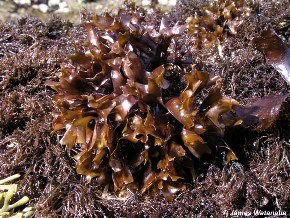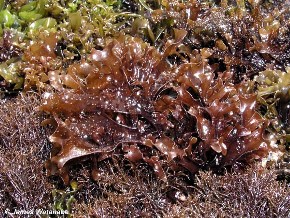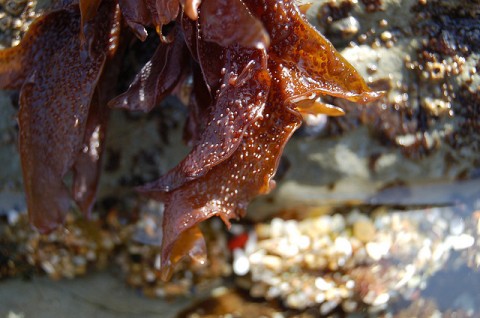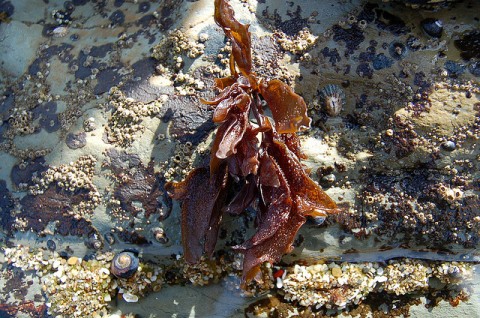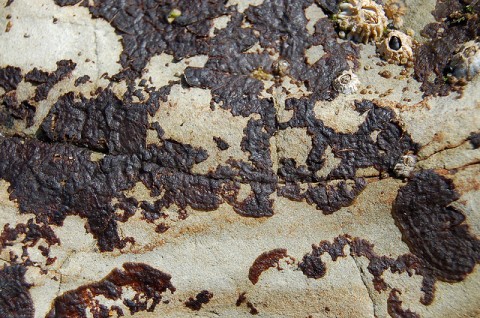
Reproduction
Reproduction
Probably not what you were expecting but still extremely interesting!!
Mastocarpus papillatus reproduces sexually. The reproductive cycle of Mastocarpus papillatus may be triggered by factors such as day length. In sexual reproduction, Mastocarpus papillatus exhibits a three-phase life cycle that has an alternation of generation. It exhibits a dominant gametophyte generation. There are separate male and female plants that produce haploid gametes. After release of male sperm, it is carried by the water column to receptive female hairs called trichogynes. Now that the male sperm is attached, it undergoes a cycle of nuclear division (mitosis) without the cell dividing. A fertilization pore is created between the spermatium and the trichogyne.
Reproduction in this
red algae is unique since no flagellated stages are ever formed. It
is generally assumed that the various reproductive spores are inert.
The spores however are still actively motile due to gliding or
amoeboid activity. The gametes are characterized as non-flagellated.
Therefore, Mastocarpus papillatus is dependent on water columns for
fertilization to occur. The gametes become fertilized and grow into
a separate generation called a tetrasporophyte. The tetrasporophyte
generation is capable of asexual reproduction even
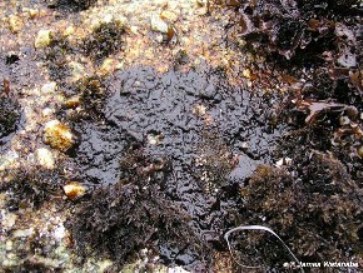 though
the organism prefers to reproduce sexual. The tetrasporophyte
generation sometimes looks exactly identical to the male and female
gametophytes that originally produced it. This is knows as an
isomorphic alternation of generations. However, in some occasions
the tetrasporophyte can look completely different and form a thin
felt-like crust on the sea bed called a Petrocelis phase. This
process is known as a heteromorphic alternation of generations. The
tetrasporophyte then produces tetrasporangia (by meiosis resulting
in four 1n spores) that are released into the water column to
germinate and complete the cycle.
though
the organism prefers to reproduce sexual. The tetrasporophyte
generation sometimes looks exactly identical to the male and female
gametophytes that originally produced it. This is knows as an
isomorphic alternation of generations. However, in some occasions
the tetrasporophyte can look completely different and form a thin
felt-like crust on the sea bed called a Petrocelis phase. This
process is known as a heteromorphic alternation of generations. The
tetrasporophyte then produces tetrasporangia (by meiosis resulting
in four 1n spores) that are released into the water column to
germinate and complete the cycle.
Other Images of Life Cycle Stages
Female Gametophyte
You can see the many little papillae present in this image. Papillae is where fertilization occurs so these papillae are only present on the female gametophyte.
Upright Petrocelis Stage
This sprouts from the encrusted Petrocelis stage. This gets knocked off the substrate by powerful waves so a brand new Mastocarpus papillatus can form.
Encrusted Petrocelis Stage
This stage looks like tar! You can understand why scientist
use to think the two Petrocelis stages where two different species.
This encrusted stage gives rise to the upright stage and can stay
stuck to the substrate for years.
You know all about how Mastocarpus papillatus reproduces safely, but if don't practice safe sex yourself, you will be very interest to learn about the Medicinal Uses of Mastocarpus papillatus!
Click here to go back to the Home Page.
